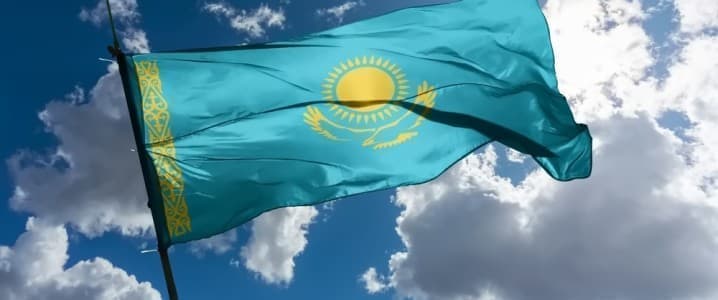Kazakhstan is now richer than Russia.
That is according to the latest data from the International Monetary Fund, showing Kazakh GDP per capita is projected to hit an all-time high of $14,770 this year, compared with Russia’s $14,260.
The fresh numbers, updated earlier in August, show Kazakhstan’s GDP per capita now leads all post-Soviet states other than the Baltics and is even running ahead of China’s.
The data helps illustrate Kazakhstan’s impressive economic growth over the past quarter-century, fueled by oil and mineral wealth. At the same time, it overshadows worries about slumping oil prices, rising government debt, and persistent inflation.
“It is a historical achievement that we’ve passed them … Russia’s always been the biggest economy of the ex-Soviet countries,” Kazakh financial analyst Rassul Rysmambetov said in an August 16 interview with Current Time TV, an affiliate of Radio Free Europe/Radio Liberty.
“It looks good,” he said. “But it doesn’t reflect everything.”
The IMF briefly pegged Kazakh GDP per capita as higher than Russia’s once before, in 2015, when both countries’ economies were in disarray due to the dramatic drop in oil prices, but analysts view this occasion as more significant.
After the pandemic, Kazakhstan’s economy has shown significant strength and grown at a rate of 6.2 percent in the first half of this year. Sectors like transportation and construction have seen particularly strong growth this year, according to Forbes Kazakhstan.
Kazakhstan’s economy continues to lead its Central Asian neighbors by a wide margin. Turkmenistan, with its vast natural gas reserves, is projected to have a GDP per capita of $13,340 by the end of 2025, while Uzbekistan comes in at $3,510, Kyrgyzstan at $2,750 and Tajikistan $1,430, according to the same IMF data.
However, the figures come with a bundle of caveats. The World Bank, which also calculates GDP, still puts Kazakhstan behind Russia in GDP per capita by about $800 a person, though its latest data is from last year.
And, IMF statistics that adjust GDP per capita for purchasing power, which takes consumer prices into account, show Russia maintains a lead over Kazakhstan at $49,380 to $44,450, implying that even if Kazakhs have more in the bank, the ruble goes farther than the tenge at checkout.
Whatever the technicalities, all the data show that since the pandemic, the Kazakh economy has pulled just about even with Russia’s.
Though there are many factors that have pushed Kazakhstan’s GDP per capita past Russia’s, one stands out, economist Sergei Guriev said.
“Kazakhstan isn’t under economic sanctions,” Guriev told reporters on the sidelines of the Open Economy forum in Astana. “Kazakhstan was successful in avoiding the mistakes that Russian authorities made.”
While sanctions have strained – not stymied – the Russian economy, they have proven a bit of a boon for Kazakhstan.
Europe has replaced much of its Russian oil with Kazakh crude, which the Kazakhs can sell at market price, while the price of Russian oil is capped at $60. Additionally, the war has given further impetus to investments in the Middle Corridor: many international firms have moved their distribution operations to Kazakhstan from Russia to avoid sanctions headaches.
There could be a little turbulence on the horizon, though.
The price of oil, to which the Kazakh economy remains tightly bound despite reform efforts, has slumped in the past year. The European benchmark Brent crude, for instance, has fallen from $76 a barrel in August 2024 to $66 this month, and the OPEC+ cartel of oil-producing states, which includes Kazakhstan, intends to hike production by 547,000 barrels a day in September.
Kazakhstan loses about $570 million for every dollar that comes off the price of a barrel, according to the Belgian bank ING. Kazakhstan already ran a hefty $7.7 billion budget deficit last year.
Astana is getting a taste of its own medicine. Kazakhstan has been flagrantly exceeding its OPEC+ quota by hundreds of thousands of barrels a month since the beginning of the year, after the expansion of the Tengiz oilfield opened in January, creating tensions within the cartel.
Inflation, too, has proven sticky in Kazakhstan, with prices rising by 10 percent year-over-year in the spring.
President Donald Trump’s tariffs have had little direct effect, as less than 3 percent of Kazakh exports overall go to the U.S., and more than 90 percent of U.S.-bound goods are exempt.
But the secondary effects of a slowdown in China, Kazakhstan’s biggest trading partner, or Europe, which buys 80 percent of its oil, could have considerable impacts.
Analysts, however, remain confident that robust growth in Kazakhstan will continue.
At the end of July, the IMF projected Kazakhstan’s economic growth rate at 5 percent this year and 4.3 percent in 2026. That means the chances are slim that Russia will regain its GDP per capita lead, given that the IMF forecasts its economy to grow at about 1 percent.
More Top Reads From Oilprice.com
